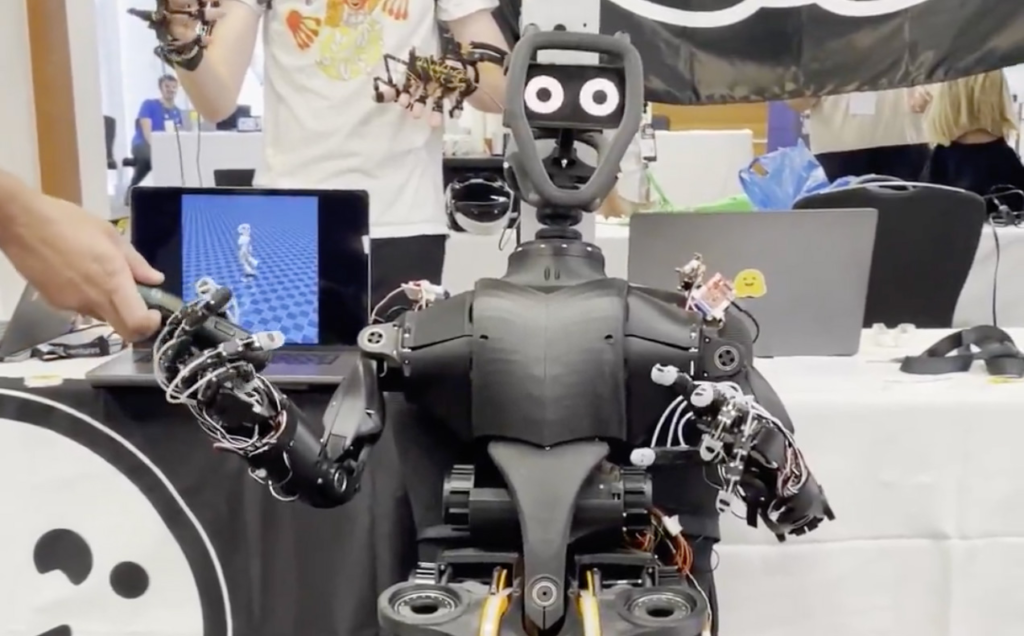In a groundbreaking development, Hugging Face — the well-known AI platform — has announced a compact, efficient robotics model capable of running on standard MacBooks. This advancement significantly lowers the hardware barrier for robotics developers and researchers, opening the door to AI innovation without the need for expensive computing resources.
This move is seen as a major step toward democratizing robotics and bringing advanced AI into everyday development environments.
AI in Robotics Gets a Lightweight Makeover

Robotics and AI have traditionally required high-powered servers or cloud-based GPUs. However, Hugging Face’s latest offering challenges that standard. The new model is designed with efficiency in mind, allowing developers to train and run robotic functions directly on consumer-level hardware like a MacBook Pro.
This robotics model is part of Hugging Face’s growing suite of open-source tools. According to the company, the model leverages recent breakthroughs in machine learning optimization and transformer architecture compression, making it suitable for devices with limited GPU capacity.
Learn more about Hugging Face’s AI tools here.
Why This Matters: Accessibility and Innovation
One of the biggest barriers in AI and robotics development is the cost of high-performance computing hardware. Until now, creating and training robotic models often required GPU-heavy setups or cloud credits running into thousands of dollars.
By making robotics modeling viable on everyday laptops, Hugging Face empowers a broader community of developers, students, hobbyists, and startups. This is particularly beneficial for institutions and individuals in regions with limited access to high-end computing.
As AI becomes increasingly integrated into physical systems like drones, smart appliances, and industrial robots, this lightweight model could accelerate experimentation and innovation across a wide variety of sectors.
What the Model Can Do
Despite being compact, the model supports many robotic applications, including:
- Path planning
- Vision-based navigation
- Object detection
- Manipulation and grip control
- Natural language instruction following
It integrates easily with popular robotics frameworks like ROS (Robot Operating System), PyBullet, and even Unity. Hugging Face has also ensured compatibility with Apple’s M1 and M2 chips, optimizing performance without draining battery life.
For developers already using Hugging Face’s transformers library, this model can be easily added to workflows via a few lines of code, just like downloading any other pre-trained model.
A Collaboration With Robotics Researchers
The robotics model wasn’t developed in isolation. Hugging Face worked closely with academic researchers and AI engineers from institutions like MIT and Stanford. The goal was to create a model that could not only operate with limited compute resources but also maintain accuracy, responsiveness, and learning capabilities.
Their success points toward a larger trend: the decentralization of AI research and deployment. With initiatives like these, more developers can participate in advanced AI innovation without being tied to large cloud infrastructures.
Explore other collaborations by Hugging Face with top universities here.
Real-World Applications

Startups and research teams have already begun experimenting with the new robotics model. Use cases include:
- Educational robots used in classrooms for teaching STEM
- Indoor delivery robots that learn from navigation data
- Home automation bots with visual and speech capabilities
- Mini drones capable of object tracking
By deploying these AI models locally on devices, developers also benefit from reduced latency and increased privacy — two key factors for sensitive or real-time applications.
Privacy and Energy Efficiency
One often overlooked benefit of local AI processing is data privacy. Since the model doesn’t rely on cloud servers, it minimizes data transmission risks. This makes it ideal for sectors like healthcare and education, where data sensitivity is a top concern.
Additionally, the model’s power consumption is significantly lower than traditional solutions. Running on a MacBook consumes only a fraction of the energy compared to running models on cloud GPUs, aligning with current goals for green AI and sustainable computing.
Read more about the environmental impact of AI here.
Developer-Friendly and Open-Source
In line with Hugging Face’s mission, the new robotics model is fully open-source. Developers can access the model, contribute improvements, and modify it to suit specific needs. Documentation is thorough, with guides, tutorials, and integration examples available on Hugging Face’s official platform.
The ease of use is another winning point. Developers familiar with Python and PyTorch can get started in minutes, without needing to rewrite code or configure complex environments.
What’s Next for AI and Robotics?
The introduction of this compact robotics model marks a shift in how AI-powered machines will be developed and deployed in the future. By eliminating the need for high-end infrastructure, Hugging Face makes robotics development more inclusive, affordable, and scalable.
Industry watchers predict that similar models will soon emerge in related fields, such as edge computing, autonomous vehicles, and AI-enabled IoT devices.
In the meantime, Hugging Face continues to lead the charge in making AI more accessible. Whether you’re a student building your first robot or a startup prototyping a product, this new model represents a major leap forward.
Stay updated with Hugging Face’s latest innovations here.
Conclusion
Hugging Face’s efficient robotics model is more than a technical achievement — it’s a strategic move toward democratizing robotics and AI. As this lightweight model gains traction, it may very well become the foundation for the next generation of intelligent machines — built not in labs with massive servers, but on the laptops of everyday innovators.
Also Read – Google Drive’s New AI Feature ‘Catch Me Up’ Simplifies Document Tracking






